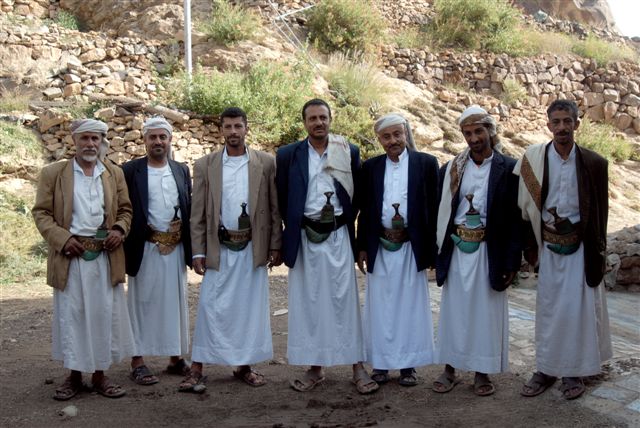Our Blog

Yemen Mocca: Coffee, not Chocolate – by Martin Diedrich
If coffee were a tribe, Yemen Mocca would definitely be the shaman.

Cappucino, Cafe Latte, or Cafe au Lait are unmistakably coffee beverages, while Cafe Mocha is thought of as a hot chocolate with coffee or espresso, or generally a chocolate based drink spiked with coffee. To get to the point of setting the record straight on this matter we must travel back intime to a distant corner of the globe. At the very Southern tip of the Arabian Penninsula, flanked by the Red Sea and the Indian Ocean, is the remote country of Yemen. Coffee Arabica was named for this place. It has resisted the modern world until just recently, and then only in the most readily accessible places, while in the mountainous hinterlands one can still feel the pulse of medieval times.
The steep, rugged mountains of Western Yemen trap enough rain, generated by the monsoons off the Indian Ocean, to sustain vibrant coffee growth. In the often inaccessible highland valleys, the terrain is dramatic, wild and rocky. It seems as if every ince of arable land is terraced with ingenious irrigation systems to trap the precious rain. The camels, donkeys, goats, and ancient fortified villages of stone houses clinging to the steep slopes create a biblical panorama.
In Yemen, coffee has been in use since at least the sixth century, and very probably much earlier. For nearly three centuries, Yemen held the world monopoly on coffee. The port of Al-Makha (from which we get “mocha”) on the Red Sea became the most important coffee port in the world. Meanwhile in Europe and North America, the growing popularity of coffee made it nearly a necessary staple of life. In time, the name “mocha” from the port of origin Al-Makha, became interchangeable with coffee in the same way we use “java” today.

Chocolate, originating in the new world, came to the attention of Europeans at about the same time coffee did. It was customary in the early days to drink it as a beverage in the coffeehouses right alongside coffee. In the late 19th century, when solid “eating chocolate” was developed, it was often flavored with “mocha” as coffee was called in that day, and thus was called “mocha chocolate”.
Yemen eventually lost its predominance in the coffee trade as coffee was now growing in colonies throughout the tropical world. The port of Al-Makha fell into dis-use. Sand bars filled the once busy harbor, and today only ruins are left of the famous port. The name mocha didn’t disappear as did it’s namesake port. Although its name was more often associated with coffee flavored chocolate rather than coffee itself. Soon, outside of those in the know about coffee, mocha and chocolate were used interchangeably.
Today mocha has become a dog chasing its tail, where coffee is often described as being chocolaty in flavor. Let history reveal that in truth, a Cafe Mocha is really coffee flavored with chocolate.
Though almost forgotten by the rest of the world, Yemen has never given up growing coffee. A genuine Yemen Mocha/Mocca is rare and expensive, and yields one of the worlds’ most distinctive cups of coffee. Most of the usual adjectives for describing coffee do not apply. It has been said that “to compare it’s flavor with other coffees is rather like comparing wild rice with Uncle Ben’s.” It is a taste that is every bit as exotic as the environment that produced it. Piquant, fruity acidity, winey, dried cherry, a sharply pointed aromatic character and oriental spiciness.

Comments
Where can I get some of this? This was my FAVORITE. I would buy it at the Diedrich near my house in Costa Mesa. There is no substitue. I need my fix 🙂
Some of the best coffe I have ever had!! Martin rocks thanks for the good coffee and great little location in Costa Mesa. I buy from no where else but Kean coffee when in California